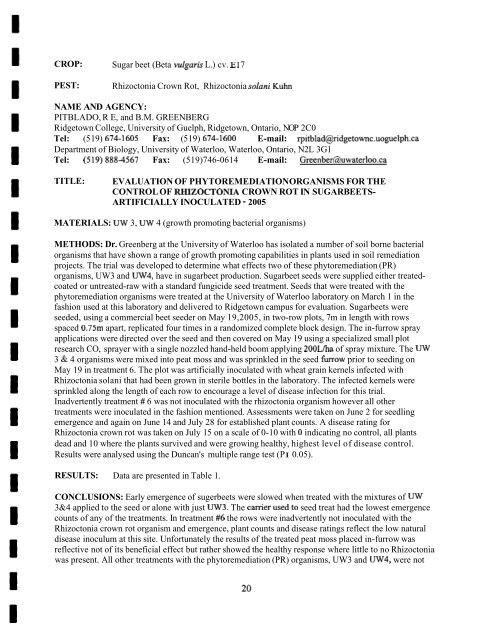ontario sugar beet growers - Atrium - University of Guelph
ontario sugar beet growers - Atrium - University of Guelph
ontario sugar beet growers - Atrium - University of Guelph
Create successful ePaper yourself
Turn your PDF publications into a flip-book with our unique Google optimized e-Paper software.
CROP: Sugar <strong>beet</strong> (Beta vulgaris L.) cv. El 7<br />
PEST:<br />
Rhizoctonia Crown Rot, Rhizoctonia solani Kuhn<br />
NAME AND AGENCY:<br />
PITBLADO, R E, and B.M. GREENBERG<br />
Ridgetown College, <strong>University</strong> <strong>of</strong> <strong>Guelph</strong>, Ridgetown, Ontario, NOP 2C0<br />
Tel: (5 19) 674- 1605 Fax: (5 19) 674-1 600 E-mail: rpitblad@ridgetownc.uoguelph.ca<br />
Department <strong>of</strong> Biology, <strong>University</strong> <strong>of</strong> Waterloo, Waterloo, Ontario, N2L 3G1<br />
Tel: (519)8884567 Fax: (519)746-0614 E-mail: Greenber@,uwaterloo.ca<br />
TITLE:<br />
EVALUATION OF PHYTOREMEDIATION ORGANISMS FOR THE<br />
CONTROL OF RHIZOCTONIA CROWN ROT IN SUGARBEETS-<br />
ARTIFICIALLY INOCULATED - 2005<br />
MATERIALS: UW 3, UW 4 (growth promoting bacterial organisms)<br />
METHODS: Dr. Greenberg at the <strong>University</strong> <strong>of</strong> Waterloo has isolated a number <strong>of</strong> soil borne bacterial<br />
organisms that have shown a range <strong>of</strong> growth promoting capabilities in plants used in soil remediation<br />
projects. The trial was developed to determine what effects two <strong>of</strong> these phytoremediation (PR)<br />
organisms, UW3 and UW4, have in <strong>sugar</strong><strong>beet</strong> production. Sugar<strong>beet</strong> seeds were supplied either treatedcoated<br />
or untreated-raw with a standard fungicide seed treatment. Seeds that were treated with the<br />
phytoremediation organisms were treated at the <strong>University</strong> <strong>of</strong> Waterloo laboratory on March 1 in the<br />
fashion used at this laboratory and delivered to Ridgetown campus for evaluation. Sugar<strong>beet</strong>s were<br />
seeded, using a commercial <strong>beet</strong> seeder on May 19,2005, in two-row plots, 7m in length with rows<br />
spaced 0.75m apart, replicated four times in a randomized complete block design. The in-furrow spray<br />
applications were directed over the seed and then covered on May 19 using a specialized small plot<br />
research CO, sprayer with a single nozzled hand-held boom applying 200Lha <strong>of</strong> spray mixture. The UW<br />
3 & 4 organisms were mixed into peat moss and was sprinkled in the seed furrow prior to seeding on<br />
May 19 in treatment 6. The plot was artificially inoculated with wheat grain kernels infected with<br />
Rhizoctonia solani that had been grown in sterile bottles in the laboratory. The infected kernels were<br />
sprinkled along the length <strong>of</strong> each row to encourage a level <strong>of</strong> disease infection for this trial.<br />
Inadvertently treatment # 6 was not inoculated with the rhizoctonia organism however all other<br />
treatments were inoculated in the fashion mentioned. Assessments were taken on June 2 for seedling<br />
emergence and again on June 14 and July 28 for established plant counts. A disease rating for<br />
Rhizoctonia crown rot was taken on July 15 on a scale <strong>of</strong> 0-10 with 0 indicating no control, all plants<br />
dead and 10 where the plants survived and were growing healthy, highest level <strong>of</strong> disease control.<br />
Results were analysed using the Duncan's multiple range test (PI 0.05).<br />
RESULTS: Data are presented in Table 1.<br />
CONCLUSIONS: Early emergence <strong>of</strong> suger<strong>beet</strong>s were slowed when treated with the mixtures <strong>of</strong> UW<br />
3&4 applied to the seed or alone with just UW3. The carrier used40 seed treat had the lowest emergence<br />
counts <strong>of</strong> any <strong>of</strong> the treatments. In treatment #6 the rows were inadvertently not inoculated with the<br />
Rhizoctonia crown rot organism and emergence, plant counts and disease ratings reflect the low natural<br />
disease inoculum at this site. Unfortunately the results <strong>of</strong> the treated peat moss placed in-furrow was<br />
reflective not <strong>of</strong> its beneficial effect but rather showed the healthy response where little to no Rhizoctonia<br />
was present. All other treatments with the phytoremediation (PR) organisms, UW3 and UW4, were not

















